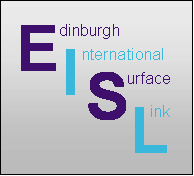 |
Edinburgh International Surface Link
Outline proposals for review and comment |
||||||||||
| Home | EARL, Gogar and trams | Development and objectives | EISL A | EISL B | Conclusions | About |
|
The EISL B rail alignments do not meet the objectives set out in the
Objectives
section concerning track curvature and gradients for the E&G line. The EARL proposals would not have met these objectives either. Nonetheless, the EISL B proposals are entirely feasible and will cause no unacceptable increase in rail journey times. The alignments proposed here were not considered in the
2003 EARL feasibility study. The proposed rail alignments are on the surface or in cuttings using conventional proven technology with low risk of construction delay or cost overrun.
The railway station will initially have two full length (250m) platforms capable of receiving all current main line trains up to 11 carriages. It will be in a cutting but not enclosed. The cutting for the station will be sufficient to accommodate expansion to four platforms, with a platform arrangement and sizes similar to those at Haymarket station. The tracks at the station will be about 5m below the current ground level. Most of the land for the new station will be acquired from the Port Royal golf range, which should be capable of remaining viable with the reduced land area.
An overbridge will be built to carry Eastfield Road on its present alignment and at its present elevation over the new railway which will be in a cutting beneath it. Fairview Road will be bisected by the new station. The Western stub of Fairview Road, serving the RHC, will be diverted to run south of the new railway to join Eastfield Road just south of its new overbridge.
A booking hall will be constructed over the station at the present ground level. Road access will be from the eastern stub of Fairview Road which will become the station access road.
Edinburgh International station will expand to four platforms with EISL B2, each platform capable of accommodating 11-car trains, suitable for all current East Coast Main Line and Cross-Country long-distance trains. The configuration of the platforms will make it easy for infrequent rail passengers, such as visitors arriving at the airport, to find the first train to Edinburgh.
Figure 19 shows the arrangement.
The central island platform will serve trains bound for Edinburgh from both the Fife lines and the Glasgow lines. This enables passengers from the airport to be directed simply at the station to this platform and to board the first train that arrives in order to reach Edinburgh Waverley. (This differs from the arrangement at Haymarket station, where trains to Waverley leave from two non-adjacent platforms connected by a footbridge.)
|

EISL B station site 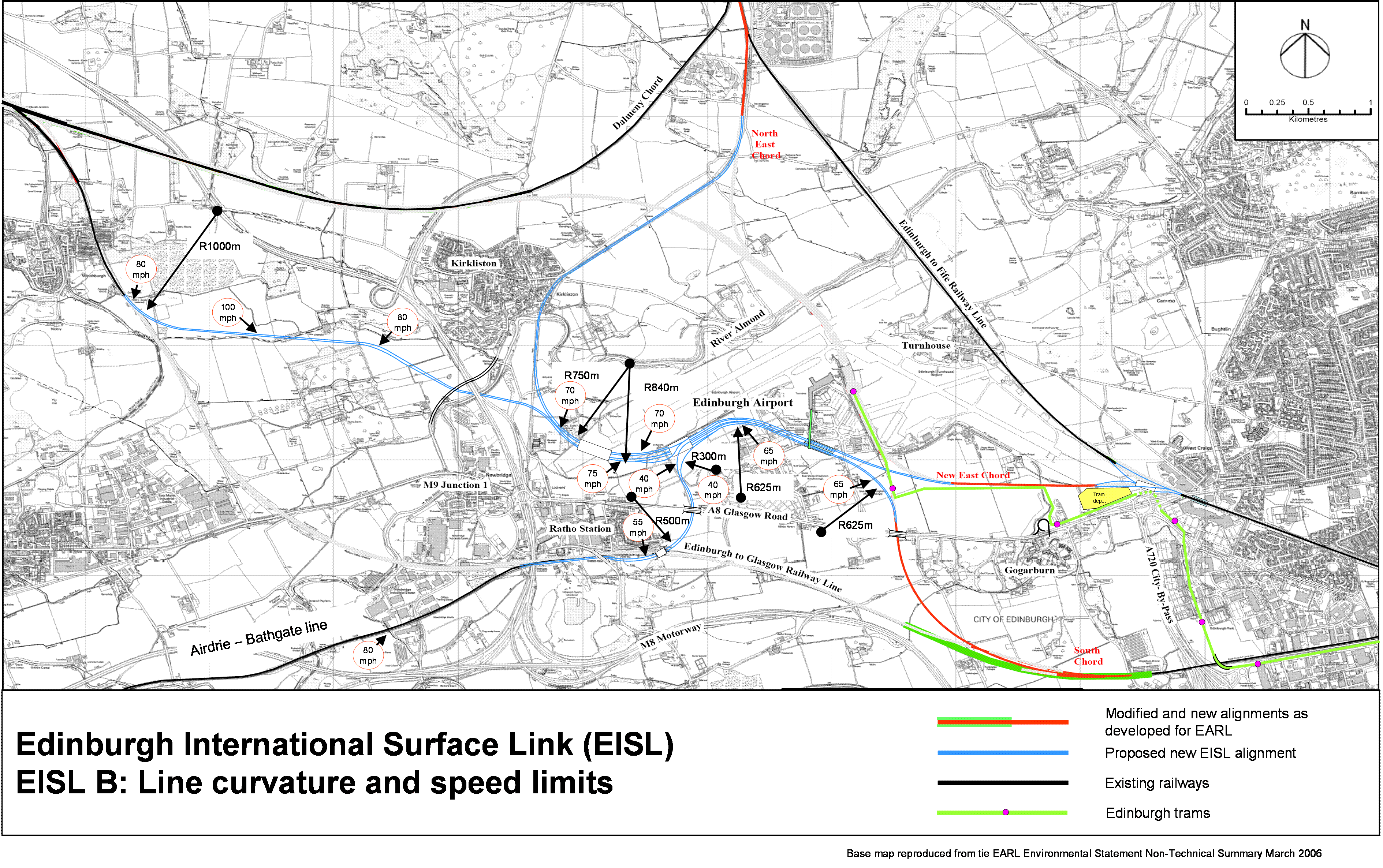
EISL B curvature and speed limits |
||||||||||||||||||||||||||||||||||||
EISL B1EISL B1 routeEISL B1 will divert only the Airdrie-Bathgate line through the new Edinburgh International station. Figure 20 shows the route diagram. The Edinburgh and Glasgow line via Falkirk (E&G) is not directly affected by this initial EISL B1 route. Services on that line will benefit, however, from the removal of the flat crossing at Newbridge that could otherwise delay trains that are on conflicting paths with those on the Airdrie-Bathgate line. EISL B1 therefore supports improvements to the frequency and speed of the E&G service.The configuration of the rail lines is shown diagrammatically in Figure 21. Figure 22 shows the EISL B1 rail alignment and Figure 23 is an aerial view. Newbridge to RathoThe line from Ratho to Newbridge will be converted from two to four tracks. This will require the Harvest Road bridge at Ratho Station to be reconstructed. The conversion to four tracks for the EISL B proposals will be less complex that that for the EISL A proposals. The two tracks serving the E&G line will not be directly affected and can remain live during most of the work. The two new tracks for the Airdrie – Bathgate line can be constructed to the south of the existing tracks, albeit with a steeper gradient requiring a retaining wall to secure the E&G line. The new tracks will have a gradient of 1:85, much steeper than the 1:960 of the E&G line. It is possible that a detailed feasibility study of the configuration east of Ratho for EISL B1 may show that a short section of tunnel would be more cost effective than the deep cuttings and new rail bridge contemplated here. A tunnel, when completed, would be less intrusive for the grounds of the Norton House hotel.At Newbridge, the existing junction will be decommissioned and the two Airdrie-Bathgate tracks diverge from the two E&G tracks with no points or crossings. The rail crossing of the M8 motorway already incorporates two double-track width bridges which can accommodate the proposed EISL B1 alignments without modification, as shown in the aerial view in Figure 2. EISL B1 alignmentTravelling west, EISL B1 will leave the E&G line at Roddinglaw, using the design of grade-separated junction already developed for the EARL project. It will follow the EARL alignment to pass under the A8 before turning north west to the new station site in a cutting. Thereafter, the line passes north of the RHC. The line turns to the south west through the area currently used for car parking by the RHC, parallel to the airport runway and still in a cutting. The line then turns south to pass back under the A8 to Ratho where it passes under the new rail bridge under the E&G line. There is no connection to the E&G line here.The alignment for EISL B1 includes sharp radius curves at Ratho, as well as the 1:85 gradient. These curves may have to be as sharp as 500m radius which would limit the speed of the trains to about 55 mph. Moreover, the design of Ingliston junction (see Figure 28) is such that the Airdrie – Bathgate line is likely to carry a speed restriction of about 40 mph there. However, because all trains on the Airdrie - Bathgate line will be stopping at the new station, the rail alignment itself should not add materially to the journey times of the service. A full alignment of the EISL B1 proposal is shown in Appendix B1. Track curvature and line speeds are shown in Appendix B5. Track gradients and elevations are shown in Appendix B6. |

EISL B1 service 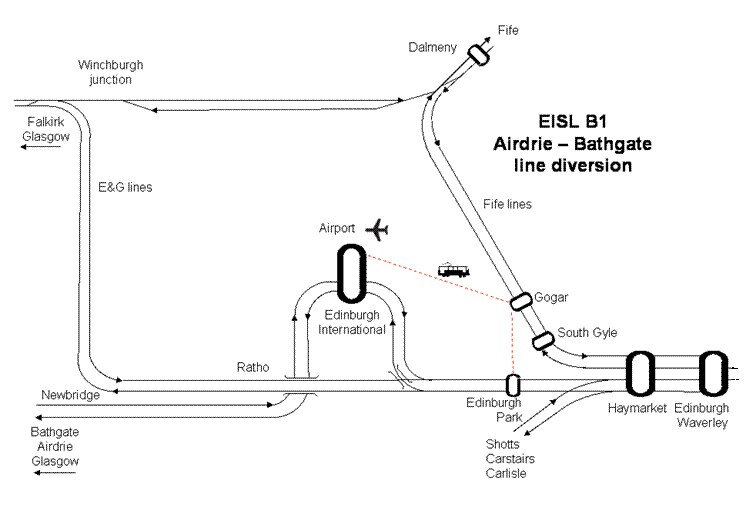
EISL B1 track configuration (diagrammatic - not to scale) 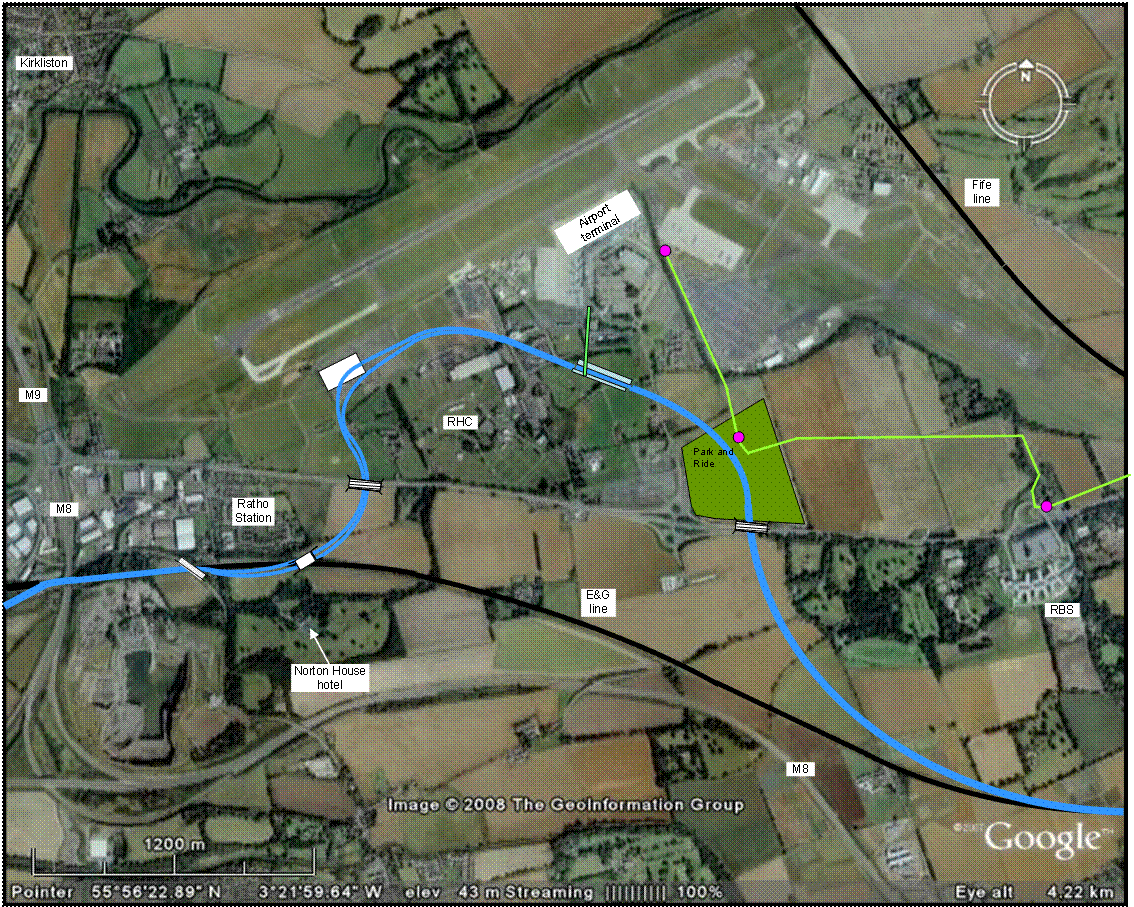
EISL B1 aerial view |
||||||||||||||||||||||||||||||||||||
EISL B2EISL B2 routeEISL B2 will provide a loop on the Fife lines to enable trains to and from Fife, Dundee, Aberdeen, Perth and Inverness to call at Edinburgh International. The route diagram is shown in Figure 24. There will be at least eight trains per hour from Edinburgh International to Edinburgh Waverley (four from Fife and four from Glasgow via Airdrie). The present Fife line to the east of the airport will be retained to ensure that trains not stopping at Edinburgh International on the Fife lines can maintain their flagship journey times to Aberdeen and Inverness. Otherwise the loop and the extra station stop would add approximately seven minutes to their journey times.The proposed configuration of the rail lines is shown in Figure 25. The EISL B2 lines will be flipped, such that trains run on the right hand track, for approximately 1,500m of the new route to enable the EISL B platform arrangement at Edinburgh International, shown in Figure 19. The proposed alignment for EISL B2 is shown in Figure 26. Figure 27 shows an aerial view of the alignment. Gogar junctionThe EISL B2 tracks will diverge from the Fife lines immediately north of the A8 road bridge at Gogar. A grade separated junction will be created whereby the northbound Fife line will dive under a new rail bridge carrying the southbound EISL B2 line. The northbound EISL B2 line will diverge from the existing Fife line north of the new rail bridge, thereby flipping the EISL B2 lines to run on the right hand tracks.The EISL B2 lines will follow the EARL alignment westwards, crossing the Gogar burn just to the north of the tram line and at the same height as the trams. It will run parallel to the tram line but fall after the Gogar burn at a gradient of about 1:100 until it passes under the tram line to the north of the Park & Ride site. It will continue in a cutting to cross under the Eastfield Road bridge constructed for EISL B1. The EISL B2 lines will serve the two additional platforms at Edinburgh International and continue parallel to the EISL B1 lines in four track formation. Prior to the EISL B3 phase, the EISL B1 and EISL B2 lines will have no connection to each other, thereby minimising operating costs and operational complexity. Ingliston junctionTo the north west of the current RHC site, where the EISL B1 lines turn to the south, a new grade-separated junction will be built, to be known as Ingliston junction. This facilitates the future construction of EISL B3 and provides the second flip for the EISL B2 lines to return them to left side running.The configuration of the proposed Ingliston junction is shown in Figure 28, which includes (in blue) provision for the future EISL B3 lines. Until EISL B3 is built, there will be no junction or points at Ingliston. The box constructed as part of EISL B2 will serve only to effect the flip of the EISL B2 (Fife loop) lines. However, this civil engineering is necessary to enable the EISL B1 (Airdrie – Bathgate) lines to diverge from the future EISL B3 (Falkirk) lines and to enable the operational flexibility for the future EISL B3 lines to connect with both the EISL B1 and EISL B2 lines. This junction box should therefore be constructed as part of the EISL B2 project if there is any realistic prospect of EISL B3 proceeding in the foreseeable future. This single junction box provides grade-separated junctions that will fulfill the intentions of the Government’s proposals for the Almond chord and obviate the need for building or upgrading junctions at Dalmeny and Winchburgh. The funtionality of Ingliston junction, proposed here, is an alternative to the provision of three separate grade-separated junctions at Dalmeny, Winchburgh and Newbridge and offers a more cost-effective solution to providing operational flexibility to maximise the usage of the four tracks through Haymarket. Ingliston junction will be created by the construction of a box in the cutting, such that (a) the EISL B2 track from Edinburgh to Fife and (b) the EISL B1 track to Edinburgh from Glasgow via Airdrie pass over the top of the box, while the EISL B3 tracks to and from Falkirk and the southbound EISL B2 line from Fife pass through the box. EISL B3 will include a junction on the top of the box for the EISL B3 line from Edinburgh to diverge from the EISL B2 line from Edinburgh. The two tracks that pass over the box will do so close to ground level. Downhill gradients from the box are likely to be close to 1:50 to return the track elevation into the cutting as rapidly as possible and thereby minimise the land that cannot be used for future airport expansion. The uphill gradients, however, will not exceed 1:100 to ensure that all current rolling stock can operate effectively and reliably in all weathers. The electrified Airdrie – Bathgate route developed under EISL B1 will already have an uphill gradient of 1:85 south of Ingliston. Runway endThe rail alignment is designed to avoid crossing the airport runways and generally does not intrude on airport property. However, at the western end of the main runway (runway 24), the rail alignment will have to cross airport property to maintain a reasonable curvature and maintain high line speeds.The EISL B2 alignment crosses the centreline of the runway approximately 300m beyond its end. The line will traverse the airport grounds in a cutting such that no rail infrastructure (including future overhead line electrification) will be above current ground level. In line with the runway, the railway will be enclosed in a box similar to that proposed for EISL A3. Figure 29 is an aerial view of the alignment. Construction of this box will use the cut and cover method. The cost will be greater than for the two-track EISL A box. £52 million has been estimated for the cost of the four-track EISL B box (£76 million with optimism bias). As with the EISL A proposal, it is likely that the box could be constructed for much less if the airport operator co-operates fully. Newbridge wastewater treatment worksNewbridge wastewater treatment works (WWTW) is in a constrained site between the south western perimeter of the airport and the M9 / M8 junction at Newbridge. Figure 29 shows its location. The alignments of EISL B2 and EISL B3 have been determined to avoid any significant acquisition of land from this works. However, it may be possible to improve line speeds by acquiring land from this site and easing the alignment of the railway. Newbridge WWTW is operated by Thames Water under a Public Private Partnership (PPP) contract for Scottish Water.Reinstatement of disused Kirkliston railwayFrom Newbridge to Dalmeny, the EISL B2 alignment follows that proposed for EISL A3.Dalmeny junctionAt its northern end, the EISL B2 loop will rejoin the Fife lines south of Dalmeny at a new grade-separated junction. |
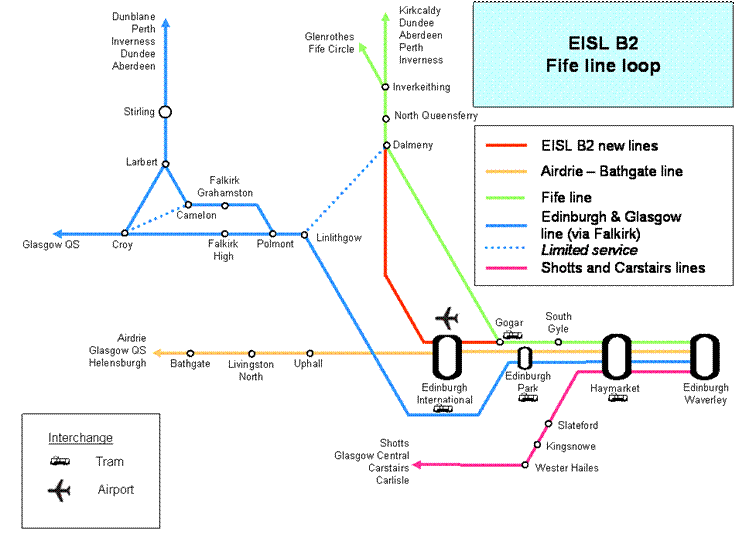
EISL B2 service 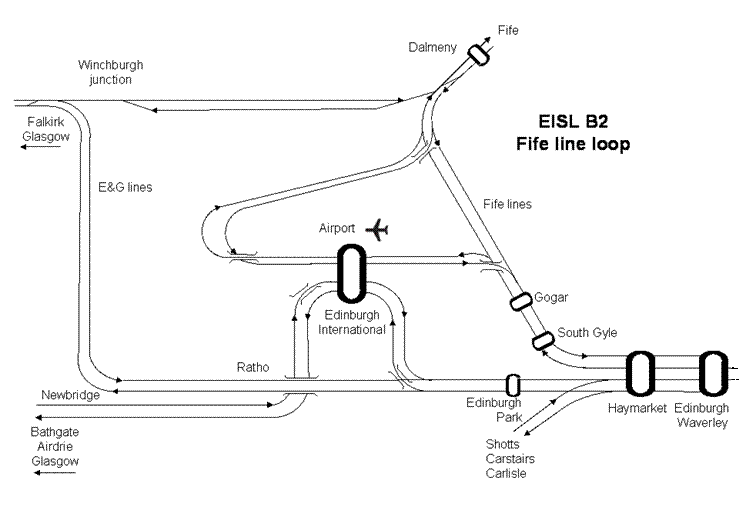
EISL B2 track configuration (diagrammatic - not to scale) 
EISL B2 alignment 
EISL B2 aerial view 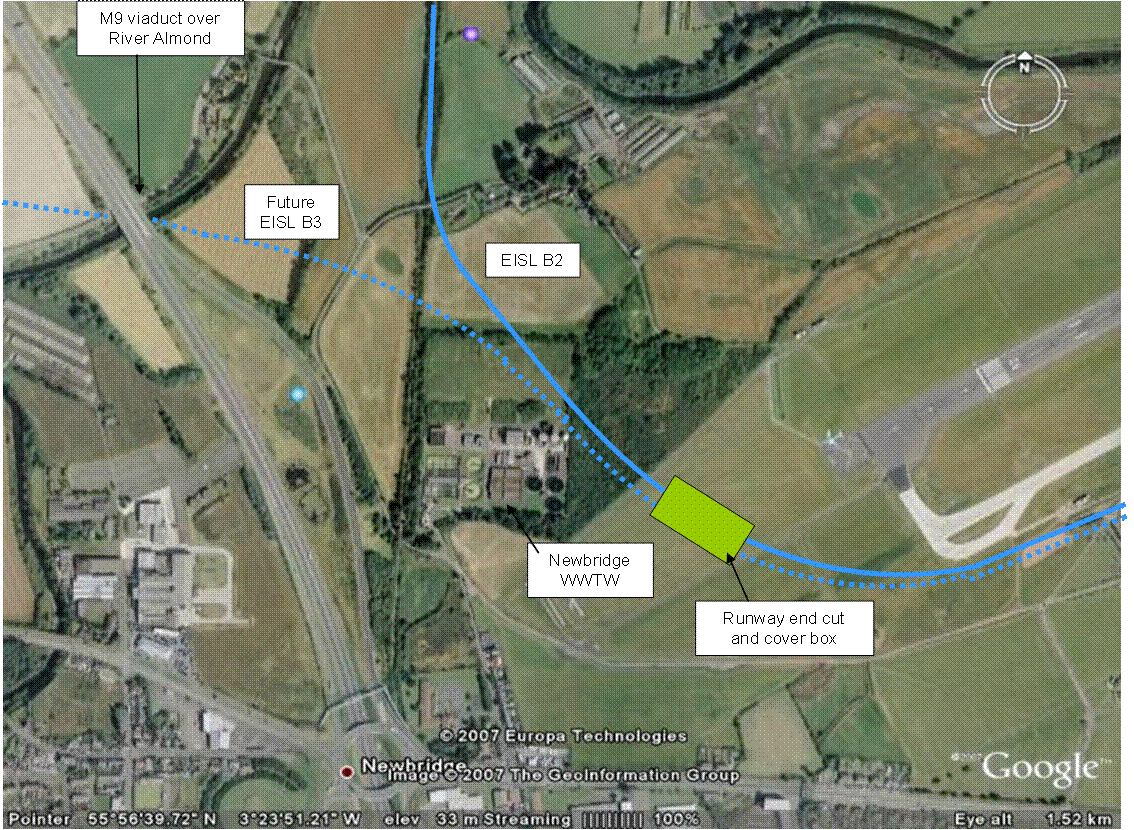
EISL B - Runway 24 end |
||||||||||||||||||||||||||||||||||||
EISL B3EISL B3 routeEISL B3 will divert the Edinburgh and Glasgow line via Falkirk (E&G) through Edinburgh International station. It will be a diversion, not a loop. The existing E&G line through Ratho and Newbridge will be decommissioned. EISL B3 offers the prospect of 17 trains per hour from Edinburgh International to Edinburgh Waverley (4 from Glasgow via Airdrie, 4 from Fife, 6 from Glasgow via Falkirk, 2 from Dunblane, 1 from Aberdeen or Inverness).A loop was considered as an alternative (i.e. the EISL B3 diversion and retention of the existing route). However, this would add operational complexity and cost and offer only very limited savings in journey time compared with the diversion via EISL B3. EISL B3 will only proceed if there is a sufficiently strong business case for trains on the E&G line to call at Edinburgh International. Therefore, most trains on the E&G line will be stopping at the station and their journey times will be affected only by the additional station stop, not by the EISL B3 alignment. We estimate the increase in journey time to be five minutes, including 150 seconds dwell time at the station. Figure 30 shows the EISL B3 route diagram and Figure 31 shows the proposed rail configuration. EISL B3 will use both the EISL B1 tracks from Edinburgh Park through Roddinglaw junction, which will be decommissioned to become plain track, and the EISL B2 tracks from Gogar, to use all four platforms at Edinburgh International. EISL B3 will complete Ingliston junction, for which the layout is shown in Figure 28. This will provide operational flexibility for trains to and from Glasgow (via Falkirk) to use either (a) the EISL B2 and Fife lines or (b) the EISL B1 and E&G lines through Haymarket to and from Edinburgh. This enables the four tracks through Haymarket to be exploited to their full capacity. EISL B3 alignmentHeading west from Edinburgh International, EISL B3 will diverge from EISL B1 and EISL B2 at the grade-separated Ingliston junction, for which the civil engineering will have been completed as part of EISL B2. The EISL B3 alignment will then run parallel to the EISL B2 tracks through the box at the end of the airport runway built for EISL B2. It will diverge from EISL B2 to the north of the Newbridge wastewater treatment works, as shown in Figure 29.The EISL B3 diversion will involve a restricted line speed of approximately 65 mph immediately north west of Edinburgh International station. This will add less than one minute to journey times for trains not stopping there, compared with the current route. The line speed could be increased by easing the rail alignment through land currently occupied by the RHC, if it were confirmed that the RHC’s move has been funded, and realigning Edinburgh International station. This realignment option has not been assessed here. M9 motorway and River AlmondEISL B3 will pass under the M9 motorway and cross the River Almond at the same point by subsuming the B800 road there. The B800 runs parallel to the river and does not cross it. The railway will cross the river on two new single-track bridges built under the M9 motorway to pass through the arches of the existing motorway viaduct, with no modification required to that viaduct. The rail elevation will probably have to be higher than the current B800 to ensure that periodic flooding of the River Almond will not affect rail services. Figure 32 shows the alignment and Figure 33 is an aerial view of the River Almond crossing.The B800 road will be diverted onto a new road bridge over the EISL B3 railway and the M9 motorway. This will be a high bridge with an associated high cost and it will reduce the visual amenity locally in Kirkliston. It is possible that detailed design work could identify alignments for both the EISL B3 railway and the B800 under the M9 through the current viaduct, avoiding the need for this expensive high bridge. However, this option is not obvious and the costings here include the possible £33 million cost of the new road bridge over the M9 with associated approach embankments. Winchburgh diversionAt its western end, EISL B3 will diverge from the current E&G alignment south of Winchburgh, immediately south of the existing rail bridge over the Niddry Burn. The new alignment will skirt Niddry Castle but require some land from the Niddry Castle Golf Club. The new EISL B3 alignment will run across agricultural land at a gradient of 1:110 to pass south of Overton but north of the grounds of Newliston House to reach the M9 and River Almond crossing. This alignment will ensure current line speeds of 100mph can be maintained and would facilitate higher future line speeds.EISL B3 will enable the decommissioning of over 5km of the current E&G line, from Winchburgh to Roddinglaw. Almond Valley viaductThe Almond Valley viaduct is a landmark on the E&G line. It will be decommissioned as a consequence of EISL B3, offering significant savings in maintenance costs.M8 motorway spur to airportDecommissioning of the E&G line will facilitate future construction of a motorway spur from the M8 motorway near Roddinglaw to the airport. It will remove the need to bridge the railway. No costs for a motorway spur have been included in the EISL proposals. |

EISL B3 service 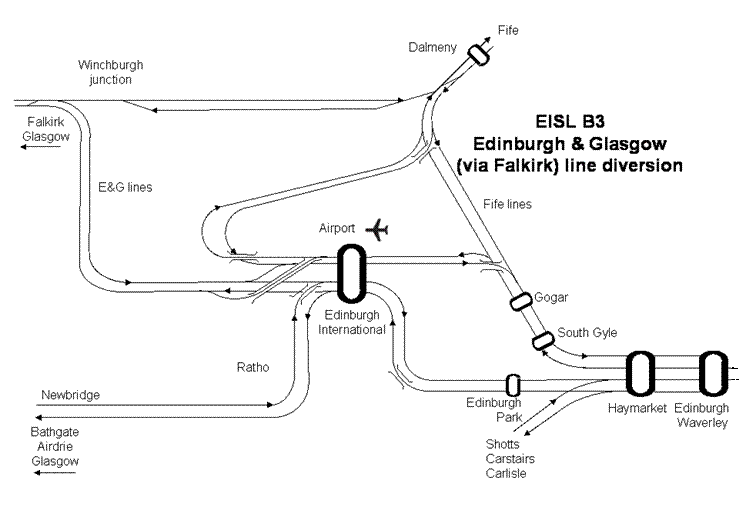
EISL B3 track configuration (diagrammatic - not to scale) 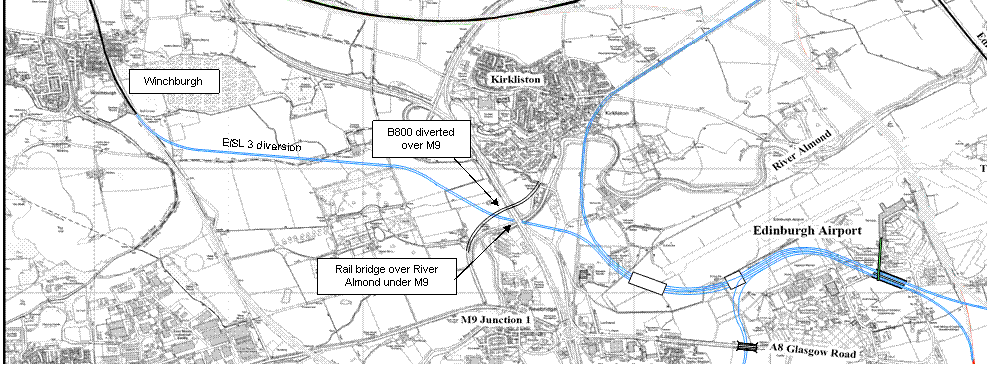
EISL B3 alignment 
EISL B3 aerial view |
||||||||||||||||||||||||||||||||||||
Airport expansion and RHC relocationThe section in the EISL A proposals concerning airport expansion and RHC relocation explained the associated assumptions. Appendix B4 shows an overlay of the EISL B proposals on the drawings of the airport expansion and the relocation of the RHC to Norton Park.Ingliston junction is the only point within the EISL B rail alignments that will require land at the current ground level to be protected, other than the railway station. In the event of major airport expansion, Ingliston junction will become an island within the expanded airport complex. All other parts of the EISL alignment can be bridged at current ground level to provide new taxi-ways and airport roads. In Appendix B4, airport expansion is indicated using a new slab over the railway to the north west of the station, to carry an expansion of the terminal building and aircraft taxiways. It also shows a suggested aircraft bridge over the railway at the western end of the runway. |
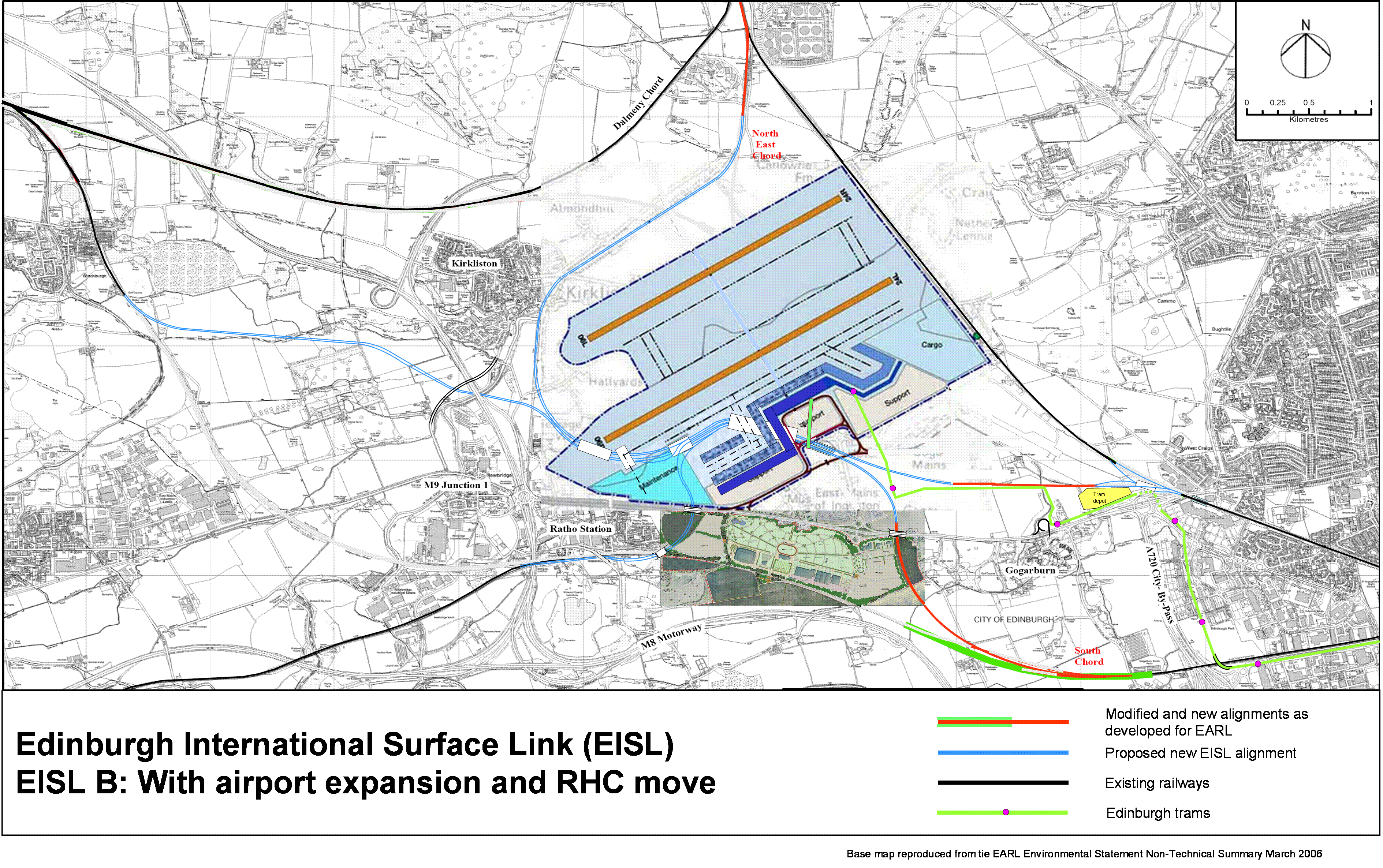
EISL B airport expansion and RHC relocation |
||||||||||||||||||||||||||||||||||||
EISL B costsCapital costsTable 4 shows the benchmark costs for each phase of the EISL B proposals, assuming that they are constructed over a number of years as three separate projects. A summary is shown in Table 3 opposite.These costs have been prepared based solely on desk studies benchmarked against comparable projects. No site surveys have been conducted. If there were the political and economic imperative to construct all three phases simultaneously, there could be savings of about £82 million. Constructing EISL B3 at the same time as EISL B1 would avoid the need for a grade-separated junction at Roddinglaw. It would also avoid the need to provide four rail tracks between Ratho and Newbridge because the EISL B1 lines would take over part of the alignment of the existing E&G lines over that route. The permanent rail underbridge proposed for EISL B1 at Ratho would be unnecessary if EISL B3 were built at the same time. Table 4 shows that the total benchmark costs for all three phases of the EISL B proposal, including 44% optimism bias, are less than £600 million. This is less than the EARL proposal and offers a major boost to the transport infrastructure of the central belt of Scotland. Operating costsIndicative marginal annual operating costs for EISL B are £2.6 million. This includes: £1 million for the operation and maintenance of the station buildings and facilities and the travelators to the airport terminal; £1.6 million for the maintenance of 16km of extra track (compared with the Gogar station and Dalmeny chord alone); and no net increase in signalling costs.
|
|
Comments on the proposals are welcome and should be sent to: admin@eisl.org.uk